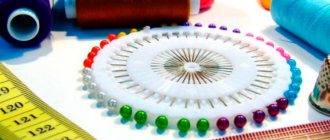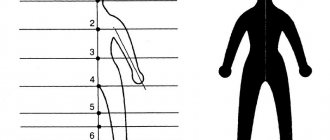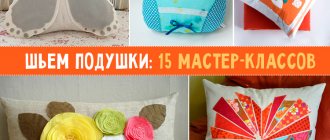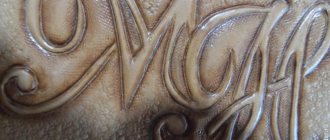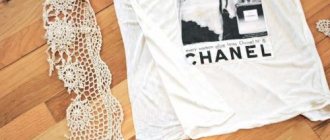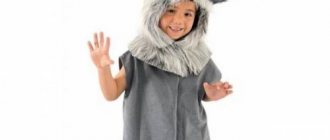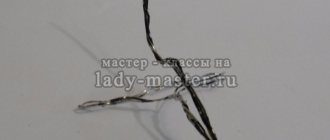History of origin
At the beginning of the twentieth century, the first educational Waldorf toys appeared in Germany.
Handicraft, as a way of understanding the world and self-expression, is the basis of the teachings of a truly comprehensive Waldorf school. In the absence of assessments and comparative characteristics between children, the child develops individually and competes exclusively with himself. As conceived by innovators from a German town, the “methodological manual” is carried out by masters - parents, children themselves, and has the features of a specific child. It is designed to develop the child’s mental and spiritual essence and harmonize his worldview.
Types of dolls
Waldorf dolls were originally created as part of a special educational program at Waldorf schools, which appeared at the beginning of the twentieth century. Over time, simple, cuddly toys became popular in many European countries.
An attractive feature of these products is that Waldorf dolls are sewn in human likeness. Since the toys are intended for children, the proportions of a child's body are taken as a basis.
There are 3 age categories, based on which experts decided how to sew a Waldorf doll.
Infancy
Toys similar to children from birth to three years old are sewn in pastel colors with an oval soft body and unpronounced limbs. It looks like they were recently swaddled.
Facial features are not embroidered or indicated schematically.
Children-toddlers
Since the body of a child aged 3 to 5 years is rapidly developing, the Waldorf doll also changes - a pattern with dimensions close to real ones is complemented by sketchy arms and legs.
The hair of these dolls is of medium length, just like that of children. Waldorf dolls in this category come with attached or removable clothing.
Preschoolers
Waldorf dolls representing children aged 5 years and above are complemented by smaller details. The feet are embroidered on the legs, and the toes are also marked with embroidery.
Long hair made of pleasant material is sewn to the head - the child can independently change the toy’s hairstyles.
Waldorf dolls are made mainly from natural fabrics, such as cotton - synthetic fabrics can cause skin irritation and allergic reactions in a child. In addition, they are not as pleasant to the touch as linen or wool. If you like the below diagram for making a Waldorf doll, then be sure to pay attention to the master class on sewing a Tilda doll.
Characteristics
“Steiner dolls” (another name for men and animals, named after the founder of the school, Rudolf Steiner), embodied the traditions of folk European textile men and animals. They are made by hand only from natural materials and stuffed with sheep wool (silver). Fleece has healing properties and keeps warm, and fabrics that are pleasant to the touch (cotton, linen) develop the baby's tactile sensations.
According to the idea of the methodologists, the dimensions of a Waldorf doll correspond to the anthropometric data of a person at different ages. The body of the baby doll is proportional to the baby’s body (the head is slightly larger and heavier than the body), and the figures depicting adults correspond to the build of an adult. This helps the child see the real picture of the world when playing.
Another pedagogical move is to change the shape and facial features of the toy. The “babies” have dots instead of eyes, and their mouths are outlined with a crescent moon. As the child grows up, the following dolls acquire a relief outline of the face.
When making a Waldorf doll with your own hands, craftsmen do not adhere to strict standards. While playing with a “girlfriend,” this contributes to the development of the baby’s imagination and fantasy.
Materials for toys
Traditional folk rag toys made from scraps of fabric, sheep wool, straw and other natural fillers were used as a prototype for the Waldorf doll. Therefore, its undoubted advantage is that it is made only by hand and is completely natural: synthetic fabrics and padding are not used. In addition to the fact that this eliminates the possibility of allergies and irritations that can occur when playing with plastic and rubber toys (especially not of very high quality), the child becomes familiar with natural materials at the level of tactile sensations.
It is generally accepted that natural materials preserve the energy of the person who made the doll. By making it for their daughter or granddaughter, mother and grandmother can convey to her their wishes of goodness and warmth.
Most often, the doll's body is sewn from cotton jersey or knitted, and the inside is stuffed with sheep wool. Using cotton wool for stuffing is not very advisable. Despite its naturalness, it is denser and heavier, so it can roll up inside the toy.
To make a Waldorf doll and its clothes, it is better to choose fabrics of neutral, soothing colors.
Where to find materials
The concept of pedagogical “idea” implies the use of specific natural materials. They are expensive, due to their “natural” nature, and are not always available on the shelves. Some components can, of course, be replaced. For example, use holofiber instead of wool. But it’s better to purchase a ready-made kit for making “Steiner dolls” at a craft store or order it online.
Features of a Waldorf doll
The rag doll was created by teachers of the Waldorf school as part of a play environment aimed at the harmonious development of children from the first days of life. It has rounded lines and a soft texture. The face does not have clearly defined features, which allows children to invest various emotions in them. In the manufacture of educational dolls, only natural materials are used that will not cause an allergic reaction in the baby. In addition, playing with a doll made from various types of fabric develops children's tactile sensations and knowledge.
Story
We are so accustomed to dolls that sometimes we don’t even think about the history and traditions of doll making. The shelves of children's toy stores are filled with an abundance of all kinds of Barbies, Bratz, Monster High and other standard products. Modern children enthusiastically collect series and play with dolls that resemble animals, aliens, and sometimes even monsters, which undoubtedly causes bewilderment and misunderstanding on the part of the older generation. Another thing is the good old rag dolls, which were made by grandmothers, mothers, and aunts from time immemorial. In ancient times, dolls also had a ritual purpose: with their help they attracted good luck, appeased the gods, and scared away evil spirits. And, of course, the doll has always been the main educational toy for children.
Materials and tools
To sew a rag doll for a baby, you don’t have to buy expensive materials. Most of the necessary fabrics and tools can be found in every home.
Selection of fabric and filler
The main criterion when choosing fabric for working on a developing rag doll is its natural origin.
The most commonly used materials are cotton, linen, and wool. Cotton knitted fabrics are selected for the head and body. They stretch well and take the desired shape. For clothing, you can take thin wool or felt fabric, flannel, satin, and so on. Sheep wool is used to fill the parts. It does not roll or get knocked down during use of the toy. Wool can be replaced with cotton wool , but it must be taken into account that this type of filler is prone to clumping.
Sewing and hair threads
To connect the doll's parts, ordinary cotton sewing threads are used. They are selected to match the fabrics used. To shape the face, floss threads and thin embroidery needles are used.
Typically, hair for rag dolls is made from wool yarn. It is also used for winding the base for the head. The hair of dolls for primary school children can be made from viscose threads obtained by unraveling satin ribbons.
Tools for work
To work on the doll you will need a simple set of tools. These include:
- sewing and embroidery needles (at least 10 cm long);
- sharp scissors;
- wax pencil or blush;
- pins.
Master class for beginners
To make a toy you will need: a pattern, knitted fabric of flesh or light pink color, undyed sheep wool, linen or cotton fabrics, a ball of wool (for the base of the head), a skein of yarn or flax fibers (for hair), floss.
Age characteristics
Educational dolls for children of different ages have their own characteristics:
- Toys for infants up to one and a half years old are light in weight and have a minimal number of parts. Most often they are made faceless or depict a sleeping face. These include butterfly dolls and knotted toys.
- Children from 1.5 to 4 years old can already play with toys that have a developed body. The eyes, mouth and cheeks are worked out on the face, but there are still no emotions. The fine motor skills of a child of primary preschool age are not yet sufficiently developed, so doll clothes are sewn to the body of the toy.
- Dolls for children 5-7 years old have detailed fingers and toes, palms and feet. They can sit and also move their arms and legs. Textile beauties have long hair, from which you can create various hairstyles. A large wardrobe is sewn for rag dolls. Children can take an active part in this work.
- A type of toy for children of senior preschool age is a cereal doll. Due to filling with various cereals, it has quite a lot of weight. This toy is aimed at developing gender skills in both girls and boys.
Types of Waldorf dolls for children of different ages
A distinctive feature of Waldorf pedagogy is that each age period corresponds to certain activities. Therefore, the Waldorf doll “grows” and changes along with the child. This is explained by the differences in the baby’s skills and abilities at each stage of his development - the toy should not be ahead of the player’s abilities.
In addition, it is known that a child often identifies with a toy, so a Waldorf doll goes through various stages of development: from an infant with a neutral appearance to an adult doll with more pronounced personality traits. This allows the baby to get the right idea about his own body and its formation.
1.5–3 years
Age-appropriate dolls have the following features:
- the shape of a baby, often swaddled so that arms and legs are not always visible;
- facial features are also often very conventional;
- it is better to make clothes that cannot be removed or in the form of an envelope for a newborn, since the fine motor skills of a child of this age are not yet sufficiently developed, and he will not be able to change the toy;
- hair is often not done, replacing it with a cap.
A Waldorf doll for a child 1.5–3 years old is made in accordance with his age needs
4–5 years
At 4–5 years old, the time comes for active mother-daughter games, when girls play out family relationships with toys. The appearance of Waldorf dolls for this age becomes more complex and elaborate:
- thumbs appear on the hands;
- the legs are more shaped like a human foot;
- facial features are still neutral in terms of emotions, but a lot of individuality is visible in them;
- hair is made long so that girls can comb and braid it;
- clothes are sewn removable, since the child’s motor skills already allow him to fasten buttons, tie strings, etc.
A Waldorf doll for children 4–5 years old has individuality and is worked out in more detail.
Elves made of wire and thread.
Craftsman Emily Lefler makes amazing elves out of wire and thread. These dolls can be played with or used as a decorative element.
For the craft, Emily uses: thread, wire, artificial flowers, glitter, hot glue and a large wooden bead for the head.
In this video she makes Christmas elves. The video language is English, but the master shows everything in detail and clearly.
And this is an extraordinary purple fairy.
In the twilight of large, dense trees, with their heads covered in a warm train, little elves fall asleep on pillows made of peacock feathers. In cups of flowers, like on a bed, On soft and fragrant feather beds, little fairies fall asleep in warm golden pajamas.
We recommend reading: Do-it-yourself doll house: made of plywood, plasterboard, PVC, cardboard
How to sew hands for a doll: patterns with descriptions and photos
To sew hands on a textile doll, you will need a lot of patience. You can sew a version for advanced people: with fingers, palms, even nails. Or you can get by with a simpler option (as in the diagram), which even beginners can do.
The description of the execution of the hand for a textile doll coincides exactly with the description of the execution of the leg:
- A stencil is cut out.
- The stencil is attached to the fabric with pins or outlined with chalk, and the blank is cut out.
- The arm blank (and the arm consists of two parts) is sewn along the edges, leaving only the upper part for attachment to the body.
- Then the future hand is filled with filler.
- After this, short stitches can be used to make the fingers. A total of 4 stitches are needed.
Diagram of a hand Hands of a textile doll
Choice of fabric and filling
The main requirement when choosing materials is their natural composition. Sliver is used as a filler. This is sheep's wool that has been specially processed, bleached and rolled into strips. In addition, wool has the ability to absorb odors, and this is very important for babies to feel the scent of their mother, even if she is not nearby.
Making a doll
For the head and body, you can use special doll knitwear; it has moderate stretch and the color matches the skin color as closely as possible. For an older child, the colors can be any, but light shades are more suitable for babies. A doll made from various materials develops the child’s tactile sensations, so when choosing fabric you can use your imagination and use materials of different textures.
Traditionally, a Waldorf doll is made from natural materials.
How to sew a large Waldorf doll: step-by-step master class
Sewing a Waldorf doll using a master class is not difficult, but it will require accuracy and patience. First of all, you need to prepare tools and materials:
- pattern;
- body fabric;
- fabric for clothing;
- sheep wool;
- long needle;
- wool yarn;
- threads;
- scissors;
- pins;
- measuring tape;
- chalk;
- floss threads.
The finished pattern needs to be printed. It consists of 4 parts - arms, legs, head and torso. It is necessary to cut out 4 parts of arms, 2 parts of legs, 2 parts of a torso, 1 part of a head.
Doll pattern
Important! When cutting parts, you need to make seam allowances of 0.5-1 cm.
How to make a doll's head
Making a doll begins with the head. You can use a foam ball as a base for it. These balls can be found in craft stores and come in different diameters. A skein of iris thread will also work. A step-by-step master class will help you make a head without difficulty:
- First you need to prepare the sliver by cutting 4 identical strips. Place them on top of each other, crossing them, aligning the middle.
- Place a ball or skein of thread in the center. Wrap the ball in strips of wool so that it is completely and evenly covered.
- Connect the tails under the ball, tie with thread and cut off the ends.
- The resulting ball needs to be measured and a rectangular piece cut out according to the size of the circle.
- Fold the rectangle and sew along the side. This will be the bottom layer of the doll's head. A face will form on it.
- The upper part of the part must be sewn with a basting seam, pulled together and the rectangle turned out.
- Place the inverted part onto the prepared ball.
You might be interested in Making snow slimes at home
First you need to prepare the drainer
Hair, eyes and mouth
On the finished head piece you need to form a face using threads:
- Wrap 2 times with thread under the ball. This will be the neck of the pupa. Tie the thread on the side where the face will be. Do not cut the thread.
- Place the threads on the sides of the ball and make a vertical tightening, tie the threads at the top of the head.
- Measure a long thread, pass it two turns horizontally in the center of the head and tie a knot in the area of the vertical drawcord.
- Combine the tightening threads with several stitches using a needle.
- At the second crossing of the threads, use a needle to make several unifying stitches and leave a tail.
- Lower the threads at the back of the head in the area of the ears and tie them around the neck.
- Hook the vertical and back threads with a needle and pull them together. Do the same on the other side.
- Roll a small ball out of wool, place it where the doll's nose will be and sew it on.
The tightening is ready, the face of the future toy is formed.
Head blank
The head piece must be sewn along the side and top seams and turned right side out. Next, you need to put the part on the prepared head and use pins to remove excess fabric. Remove the fabric, carefully turn it inside out and stitch in place of the pins. Excess fabric must be trimmed.
Place the finished part back onto the workpiece, make 2 turns of the thread around the neck, tighten and tie the thread. Secure the lower edges of the thread with a “forward needle” stitch. Mark the hair line with chalk and secure a woolen thread at the marked line. Make a stitch with a “back needle” stitch at a distance of 1 cm from the marked line. In the same way, make a stitch back to the line. So you need to stitch to the end of the line. You need to make bangs in exactly the same way; if necessary, the “hair” needs to be trimmed.
Attach pins in place of the eyes and mouth. Use a pencil to outline the shape. In the marked places, use floss threads to embroider first the eyes, and then the mouth. To hide thread knots, insert the needle under the hair and out near the eye. You can use blush to brighten your cheeks.
You might be interested in Making a voodoo doll with your own hands at home from threads and plasticine
Head of a future doll
Arms and torso
The details of the arms and body need to be transferred from the pattern to the fabric and cut out. Paired parts need to be sewn together, turned right side out and stuffed tightly with filler. Attach the finished parts of the handles to the bottom of the head using pins, check their symmetry. Carefully sew on the arms using small stitches. Sew seam allowances with coarse thread.
Attaching the head to the body
Connect the parts of the body with the legs and sew. Turn right side out. First, fill part of the legs to form the feet. Before stuffing, it is advisable to mark with chalk the place where the feet end and check their symmetry. Next, stitch the walls of the stuffed part. The remaining parts of the legs are also stuffed and sewn with a “forward needle” seam at the beginning of the body.
The body itself must be tightly filled with filler and attached to the base of the head with pins. Connect all the parts and secure the body around the neck. To make a chubby toy, the body parts need to be stuffed as tightly as possible.
Doll arms and legs
Important! All parts are connected and stitched with a hidden seam.
The doll is ready, now you can start making clothes for it.
How to make a body, torso for a doll: patterns with descriptions and photos
The body of a textile doll can be made on a frame, or sewn by hand. For beginners, we recommend the sewing method because it is simpler and less costly in terms of time and materials.
Algorithm for sewing a doll's body:
- Cut out the stencil as in the diagram below. If necessary, its size can be increased or decreased. The back and front parts of the body are the same, so you can only use one stencil.
- Place the cut out stencils on the machine and fasten with safety pins, or outline with chalk.
- Cut out two pieces of fabric using the stencil.
- From the wrong side, sew the parts together.
- Turn the product right side out and stuff the body with filler. The work is ready.
Doll body pattern diagram
Doll clothes: diagram and pattern
Pattern of clothes for a doll
When sewing clothes for a doll, be sure to choose natural materials in light shades, especially if it is a toy for a small child. Various clothes - dresses, sundresses, shorts, T-shirts, trousers. Before transferring the pattern onto the fabric, you need to do a “try-on” and check whether the sizes of the pattern and the doll match. Be sure to provide seam allowances of 0.5 cm on each side. Clothes are sewn using a sewing machine or by hand. You can knit or crochet a hat on your head.
Clothes for a doll
With such a detailed description of all stages of work on the toy, sewing it will not be very difficult. Sewing will take time, but the baby will have a unique toy made by his mother's hands with love and care.
Pattern
The craft pattern consists of a head, torso (2), arms and legs (4) parts.
Important! The product can be of any size, but age standards must be observed.
Note!
How to make wooden shelves with your own hands - original design options
Kinusaiga technique for beginners: what is it, a description of creating paintings from threads
- How to weave a figurine from rubber bands: how to learn to weave animals, toys and what you can make from rubber bands on a slingshot
According to the ratio of the head to the body:
- ¼ - for a “newborn”.
- 1/5, - from one to four years.
- 1/6, - from five to seven years.
The length of the limbs and body is 1.5 times the diameter of the head. And body width = head diameter + 1 cm. The geometric axis passes through the center of the navel, located in the center of the workpiece.
If it is difficult to create a drawing yourself, a novice needlewoman can use a ready-made life-size Waldorf doll pattern with dimensions. Practical models from “advanced” craftsmen are posted on the Internet.
The second, important stage in working with crafts is creating the body of the toy. The finished parts of the pattern are outlined on a knitted fabric with chalk (or soap), with an allowance of up to 1.5 cm for the seams, and cut out.Original finishing methods
It is believed that felt boots are originally Russian shoes, but historians assure that this information is far from the truth. Back in the 12th and 13th centuries (during the existence of the Golden Horde), the Mongols introduced their attributes into Russian culture. There was also such a craft as felting sheep wool. Felted shoes became popular only at the end of the 18th century.
We recommend reading: Do-it-yourself paper cracker, step-by-step instructions, diagram of how to make origami with confetti, from A4 sheet, notebook, bottle and ball, toilet paper rolls
For a long time, felt boots were considered “basque” shoes due to the complexity of the manufacturing process. This was the best gift for the winter holidays. Modern valeshs are also worn in winter. They are more resistant to changes in weather conditions, practical to wear, and made of high-quality materials.
Lace
Ordinary valeshes are decorated with lace. To do this, take lace and thread to secure them. But the problem is that most traditional felt boots are made of rough material, so it is necessary to select rough laces. The best option for this finishing method would be crocheted lace. Experts recommend sewing this accessory onto high felt boots. For low-rise shoes, a narrow lace ribbon is perfect. In addition, lace looks elegant if you sew it on a freebie. For greater effect, they are decorated with beads.
Fur
Fur cuffs will decorate not only boots, but also any other shoes. Both faux and natural fur can be used for decoration. To make the fur less frayed and rubbed during wear, it is recommended to use material with short pile. Decorative buttons covered in leather add elegance. Voluminous laces and fur cuffs also perfectly complement the shoes. To make the finishing look neat, the fur is sewn on the bottom and top. It is appropriate to make a joint on the inside of the leg.
Valeshis with fur pompoms are suitable for little girls. The fur balls will bounce as you walk.
Application
To make gray shoes beautiful, you can decorate them with appliqué. For this use:
- knitted patches;
- fur;
- skin;
- felt.
To begin with, they carefully develop a sketch of the future decoration, that is, they draw a composition on paper to make it easier to bring the creation to life. It can be of absolutely any theme: from ornaments in the Khokhloma or Gzhel style to floral ornaments and summer or winter landscapes. After preparing the sketch, they begin to select the necessary materials. You can combine leather and fur, and also try other variations. It is necessary to experiment. You may have to redo the sketch several times to see what happens in each specific case.
painting
Painted walleyes have gained popularity quite recently. To perform this type of work, special waterproof acrylic paints are used. To make the work look high quality, it is necessary to carefully prime the surface with PVA glue. Only the part of the felt boot that is planned to be painted is processed. It is recommended to paint with thick paints, as they adhere better to the felt material. Valeshi with national symbols and ornaments are suitable for adults, and for children - with images of any cartoon characters, cars or spaceships.
Hair dye
Felt boots can be dyed with hair dye. The image will look harmonious if you choose a paint color darker than the shoes themselves. In order for the coloring to be effective and last a long time, you must first moisten the felt a little. Then several layers of paint are applied in stages. For permanent coloring it is necessary for the paint to be absorbed. This takes about 5 minutes, then a new layer is applied. The main thing is that the paint does not dry completely. The maximum decorative effect is achieved by 4-5 layers of paint. After the dyeing procedure, the felt boots are dried for several days in a warm place (possibly on a radiator). After all the paint has been absorbed and dried, it is washed off with water and shampoo.
Snowflake
Snowflakes look appropriate on winter shoes. Felt boots decorated with snowflakes look like an element of the Snow Queen's wardrobe. You can do them in different ways:
- apply rhinestones;
- sew an applique from durable ribbons or tinsel;
- make embroidery with threads or beads.
A delicate openwork snowflake will look perfect on the top of gray felt boots. An original finishing method is to apply shiny decorative powder to the surface using PVA glue.
Beads
Beads and beads are one of the best options for decorating winter shoes. Beads or beads are sewn on with strong synthetic thread. Such decorations may get caught on clothing or other objects. If you purchase different types of beads and beads, you can create an original picture. Using these materials you can embroider:
- fireworks;
- bright abstraction;
- butterflies or flowers;
- pictures and ornaments.
Both a little girl and an adult woman will be equally pleased with felt boots embroidered with beads or beads.
Rhinestones
The felt material's structure resembles fabric, so rhinestones will attach well to it. Hot-melt or self-adhesive rhinestones are suitable. Individual rhinestones are purchased in specialized stores for creativity. But the simplest solution is to take a finished picture of rhinestones, and then transfer it to felt boots.
Working with ordinary rhinestones will take more than one hour, but they do not limit the flight of imagination at all. Rhinestones are attached to shoes using a glue gun. Before applying rhinestones to the surface of the shoe, a sketch is developed. Rhinestones in any form look elegant.
Sequins
Sequins are suitable for any work related to decorating felt boots. They are cheap, so they are in great demand. Individual sequins are attached using a glue gun. It is convenient to use sequin ribbons to decorate felt boots. They are sewn to shoes.
Embroidery
Popular ways to decorate felt boots include embroidery. Applying embroidery to felted wool is as easy as applying embroidery to regular fabric. Satin embroidery gives a beautiful bright pattern, so this finishing method is most often used to decorate gray shoes. For embroidery, floss is used exclusively. If you embroider with other threads, such as acrylic, they will tear and ruin the picture. This is due to the fact that the valeshi are rolled in a very dense layer of wool.
An embroidery needle is also selected taking into account the characteristics of the material. An ordinary needle will break very quickly. It is necessary to embroider on felt with a large needle, as it is more durable.
Satin ribbons
Satin ribbons are a good material for decoration. With their help, you can turn gray felt boots into the kind of shoes you can wear to a festive event. Thanks to the use of satin ribbons, three-dimensional and bright paintings are obtained. Floral motifs look best. But satin ribbons are not very practical, as they quickly wear out and lose their elegance.
Experts advise using felt boots with such an accessory only for going out to events. It is recommended to decorate shoes for everyday wear with a different material. For school-age girls, decorative lacing is suitable.
Diagram, instructions and photo of making a butterfly doll for a baby
The butterfly doll is considered the simplest of all Waldorf dolls. It is intended for the little ones; babies as young as 3 months can play with it. This is a wonderful and reliable toy for a baby.
The butterfly doll is intended for children from 3 months
To make a doll you will need:
- a piece of flesh-colored knitted fabric for the head and torso (12x12 cm);
- natural and pleasant fabric for overalls (42x26 cm) and cap (15x18 cm);
- a small piece of braid (16 cm).
We recommend reading: Do-it-yourself candy bar for children for a children's birthday
All parts are cut with an allowance of 0.5 cm.
Pattern for a Waldorf butterfly doll
Step 1: head
- The square of fabric should be folded in half lengthwise along the grooves of the knitted weave and the edges along the long side should be sewn with a back seam using a needle with an allowance of 0.5 cm.
- Make a basting seam along the top edge of the “pipe” and pull it together to form a “bag”. The thread must be properly secured - this will be the top of the doll.
- Separate a long narrow ribbon from the wool and wind it into a tight ball with a diameter of 5 cm.
- Separate 3 more strips 20 cm long and fold them crosswise. Place the resulting ball in the middle and tightly tie the ends of the laid out strips with thread so that they tightly clasp the ball.
- Place the ball in the case and tie it well with thread over it where the neck will be. The ends of the wool should protrude slightly from the cover. The seam should be located at the back of the head where the cap will be sewn.
Making the head of a butterfly doll - photo gallery
A piece of fabric for the head of a Waldorf butterfly doll A bag that will be the head of a Waldorf butterfly doll Rolling a ball of wool for stuffing the head of a Waldorf butterfly doll Stuffing for the head of a Waldorf butterfly doll Finished blank for the head of a Waldorf butterfly doll
Step 2: cap
- Cut out the cap according to the pattern and sew the side seam with an allowance of 0.5 cm.
- Fold the edge of the cap under or trim it with braid, attach it to the head with the seam back (for greater accuracy, combine the seam of the head and the seam of the cap), sew tightly.
We sew a cap - photo gallery
A piece of fabric for a cap for a Waldorf butterfly doll. A finished cap for a Waldorf butterfly doll.
Step 3: Torso
- Cut out the butterfly body according to the diagram.
- Sew the edges with a back seam using a needle with a 0.5 cm allowance, leaving only the neckline unsewn.
- Roll 4 small balls and place them in the limbs, wrap them tightly with thread and secure.
- Finish the neckline with a basting stitch, insert the head, tighten the thread and sew both parts together.
Body of the toy - photo gallery
A piece of fabric for clothes for a Waldorf butterfly doll Clothes for a Waldorf butterfly doll Decorating the limbs of a Waldorf butterfly doll Finished Waldorf butterfly doll
Master class “Waldorf butterfly doll” - video
Clothes and accessories
Clothing for Waldorf dolls involves natural fabrics or knitted items.
Models are sewn in such a way that they can be removed. The wardrobe requires the presence of things in different styles, so that the child himself can dress the ward to his liking. There are entire collections of outfits for dolls on the Internet. If your mother or grandmother has sewing skills, then there will be no problems with implementing ideas. In another case, master classes using photos and videos will teach you how to make patterns and sew original things using them.
It should be noted that in the toy kingdom, among textile crafts, the first was a doll - a long-legged doll. Connoisseurs of “Hand maid” do not need to explain the name of a doll with long legs.
Of course, Tilda! Her “parent” was Tone Finnanger (Norwegian designer). Tilda's concept also includes eyes - dots, grotesquely rouged cheeks, and the absence of a mouth. Tilda's fauna is inhabited by long-legged hares, cats, mice, bugs and snails.
But the difference between Tilda and the young lady from Waldorf is that the Tilda “brand” is a collectible “thing” intended for interior decor, accessories, and household items.The Waldorf doll, unlike its counterparts, is born for close physical and emotional contact between it and the child. She “grows up” together with the baby, acquiring more and more developed forms and features by the teenager himself.
Craft for older preschoolers
The technology for making a Waldorf doll for children 4-7 years old is significantly different from working on toys for children. This rather labor-intensive process is easy to master by following the step-by-step instructions, which describe in detail all stages of the work.
Preparatory stage
The main part of the preparatory stage is making the head:
- A ball of yarn with a diameter of 6 cm is placed in the center of a snowflake made from strips of wool measuring 5*50 cm. It is necessary to use from 4 to 8 layers.
- A ball of thread is wrapped with woolen ribbons, securing with thread every two layers.
- A light-colored knitted sock is pulled over the ball. The sock is wrapped tightly with thread under the base of the ball and a knot is made. The head piece is ready.
The pattern for the Waldorf doll should be printed after making the base for the head. Since the size of all other parts depends on its size. For a head with a diameter of 30 cm, a life-size pattern will fit on an A4 sheet. Before transferring the parts onto the fabric, it is folded in half and secured with pins. The silhouettes of the parts are cut out along the marked lines, leaving seam allowances of 5 mm.
Shaping the head
The head of a doll for children 4-7 years old is pulled in, forming the facial features of the toy:
- A thread folded 2-3 times is wrapped around the neck of the workpiece and tightened into a knot. The loose ends are lifted and another knot is made at the top of the figure. The end of the thread is not cut off.
- A horizontal tie is made with a length of thread, also folded in several layers. They wrap it around the head in the middle, pulling the workpiece well together horizontally. The knot is tightened to the side of the head.
- The free end of the thread is inserted into the needle and the intersection of the horizontal and vertical threads is secured with small stitches. The needle is passed through the head to the opposite point and the previous action is repeated. The ends of the threads are tied at the crown and the excess is trimmed.
- The thread from the back of the head is lowered to the neck line. A long thread is inserted into the needle and the vertical and occipital threads are pulled together on both sides.
- The nose is formed from a strip of wool, pulled together with thread and sewn to the front of the head.
- A head cover is cut out from tight knitwear. The top and side edges are stitched and turned right side out.
- The resulting cover is put on the workpiece and the excess fabric is marked with pins. After removing the fabric, the corners are stitched along the marked lines. The remaining fabric is trimmed, not forgetting the seam allowances.
- The stocking is turned inside out and put on the head. It is fixed along the neck line with a thick thread and tightened into a knot. The end of the thread is brought inside the workpiece.
- Using a working thread, the inner and outer covers are pulled together and sewn up.
Hair, eyes and mouth
You need to sew hair from yarn to the finished head blank.
The thread is threaded into a needle with a wide eye and the base for the hairstyle is made. Long ends are left along the hairline, and then three stitches are made with the seam facing forward to the needle. Having reached the top of the head, the thread is returned back and the action is repeated. According to this pattern, the entire head is covered with yarn. Strands are extended onto the finished mesh over the entire head. The stitches are made at a distance of 4-5 mm from each other and secured with a reverse stitch. The locations of the eyes and mouth are marked with pins. Floss threads are inserted from the hair side and the eyes and mouth are embroidered.
How to make a doll's head
Do-it-yourself Waldorf dolls are quite easy to create, but it takes some time before the fabric blank turns into a cute toy.
After you have finished working on the head, you can begin attaching the doll's hair. They can be made from yarn or floss.
- Using chalk or a bar of soap, mark the hairline along the head.
- Insert a needle and thread into the head at the marked line.
- Stick the needle about a centimeter from the edge and make a small stitch back with the needle, securing the hair to the head.
- Make an outside stitch back.
- Now bring the needle even further than the first bartack, closer to the crown. Fasten the thread again.
- Having reached the crown, repeat all steps in the opposite direction - towards the growth line. Thus, from one thread you will get 2 hairs at once.
- Embroider the entire head in a circle in a similar way.
- To extend hair along the entire perimeter, stick the needle in the right place, make a fastener and remove the needle from the thread - you will get 2 hairs at once.
The doll's bangs need to be sewn on in the same way as the rest of the hair - using fastening. Cut the threads, leaving the bangs at the desired length.
Also, don't forget to trim your hair so that your doll has an even, neat hairstyle.
This type of toy must have certain facial features. Use sewing pins to mark the location of the eyes and mouth.
The eyes should look like small circles - use satin stitch or small black beads. Define the mouth in the same way.
